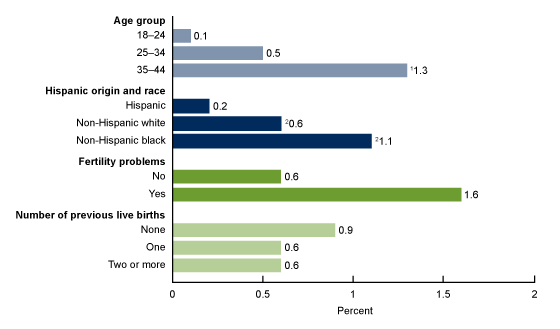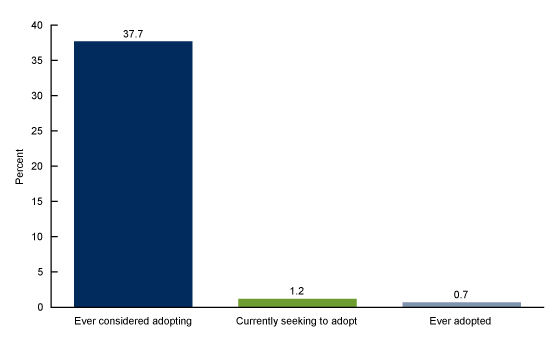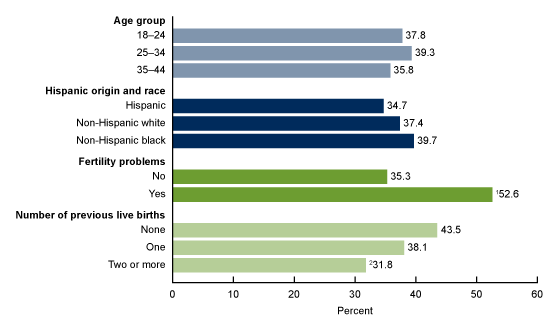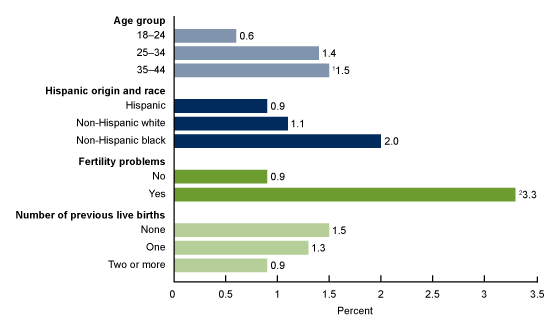Adoption-related Behaviors Among Women Aged 18–44 in the United States: 2011–2015
- Key findings
- Most women who ever considered adopting a child did not seek to adopt nor have they ever adopted a child.
- Approximately one-half of women aged 18–44 with current fertility problems had ever considered adopting a child.
- The percentage of women who were currently seeking to adopt a child was higher among women aged 25–34 and 35–44 compared with women aged 18–24, and was higher among women with current fertility problems compared with women without fertility problems.
- The percentage of women aged 18–44 who had ever adopted a child varied by age group and by race and Hispanic origin.
- Summary
- Definitions
- Data source and methods
- About the authors
- References
- Suggested citation
PDF Version (763 KB)
Chinagozi Ugwu, M.P.H., and Colleen Nugent, Ph.D.
Key findings
Data from the National Survey of Family Growth
- Nearly 4 in 10 U.S. adult women aged 18–44 in 2011–2015 had ever considered adopting a child, while less than 1% (0.7%) of women aged 18–44 had ever adopted a child.
- Approximately one-half of women aged 18–44 with current fertility problems (52.6%) had ever considered adopting.
- The percentage of women who were currently seeking to adopt a child was higher among women aged 25–34 and 35–44 compared with women aged 18–24, and among women with current fertility problems compared with women without fertility problems.
- Women aged 35–44 were more likely to have ever adopted compared with women of other age groups.
People may choose to adopt a child for several reasons, including starting or growing a family, infertility, legal acknowledgment of a parental relationship with a nonbiological child, or for humanitarian reasons (1,2). Since 1973, the National Survey of Family Growth (NSFG) has gathered data from women on adoption and adoption-related topics (3–7). Using data from NSFG, this report provides the most recent estimates on current adoption and adoption-related behaviors among women aged 18–44 in the United States in 2011–2015.
Keywords: family formation, fertility, U.S. women, National Survey of Family Growth
Most women who ever considered adopting a child did not seek to adopt nor have they ever adopted a child.
- Among women aged 18–44 in 2011–2015, 37.7% had ever considered adopting a child (Figure 1).
- In 2011–2015, 1.2% of women aged 18–44 were seeking to adopt a child and 0.7% had ever adopted a child.
Figure 1. Percentage of women aged 18–44 who ever considered adopting, were currently seeking to adopt, or had ever adopted a child: United States, 2011–2015
NOTES: Ever considered adopting a child includes women who were currently seeking to adopt and women who ever adopted a child. Currently seeking to adopt includes women who were seeking to adopt a nonbiological child living with them or another nonbiological child not living with them. Ever adopted includes women who ever adopted a child, regardless of prior relationship to that child. The adopted child could be a child of her spouse or partner or a child of another relative. Access data table for Figure 1.
SOURCE: NCHS, National Survey of Family Growth, 2011–2015.
Approximately one-half of women aged 18–44 with current fertility problems had ever considered adopting a child.
- The percentages of women who had ever considered adopting a child were similar across age groups (Figure 2).
- The percentages of women who had ever considered adopting a child were similar for Hispanic (34.7%), non-Hispanic white (37.4%), and non-Hispanic black (39.7 %) women.
- The percentage of women aged 18–44 who had ever considered adopting a child was higher for those with current fertility problems (52.6%) than for those without (35.3%).
- Among women aged 18–44, those who had never given birth were most likely to have ever considered adopting a child (43.5%), followed by women who had given birth to one child (38.1%) and women with two or more children (31.8%).
Figure 2. Percentage of women aged 18–44 who had ever considered adopting a child, by selected characteristics: United States, 2011–2015
1Significantly different from women without current fertility problems (p ≤ 0.05).
2Significant decreasing trend with increasing number of previous live births (p ≤ 0.05).
NOTES: Ever considered adopting a child includes women who were currently seeking to adopt and women who had ever adopted a child. Age, fertility problems, and number of previous live births were measured at the time of interview. Access data table for Figure 2.
SOURCE: NCHS, National Survey of Family Growth, 2011–2015.
The percentage of women who were currently seeking to adopt a child was higher among women aged 25–34 and 35–44 compared with women aged 18–24, and was higher among women with current fertility problems compared with women without fertility problems.
- Women aged 35–44 (1.5%) were more likely to be currently seeking to adopt, followed by women aged 25–34 (1.4%) and women aged 18–24 (0.6%) in 2011–2015 (Figure 3).
- The observed differences in the percentages of women currently seeking to adopt by Hispanic origin and race were not significant.
- Among women aged 18–44, those with current fertility problems (3.3%) were approximately four times as likely to be currently seeking to adopt a child as women without current fertility problems (0.9%).
- The observed decrease in the percentage of women who were currently seeking to adopt by increasing number of previous live births was not significant.
Figure 3. Percentage of women aged 18–44 who were currently seeking to adopt a child, by selected characteristics: United States, 2011–2015
1Significant increasing trend by increasing age (p ≤ 0.05).
2Significantly different from women without fertility problems (p ≤ 0.05).
NOTES: Currently seeking to adopt includes women who were seeking to adopt a nonbiological child living with them or another nonbiological child not living with them. Age, fertility problems, and number of previous live births were measured at the time of interview. Access data table for Figure 3.
SOURCE: NCHS, National Survey of Family Growth, 2011–2015.
The percentage of women aged 18–44 who had ever adopted a child varied by age group and by race and Hispanic origin.
- The percentage of women who had ever adopted a child increased with increasing age (0.1%, aged 18–24; 0.5%, aged 25–34; 1.3%, aged 35–44) (Figure 4).
- Compared with Hispanic women (0.2%), higher percentages of non-Hispanic white women (0.6%) and non-Hispanic black women (1.1%) aged 18–44 had ever adopted.
- The observed difference in the percentage of women who had ever adopted a child between those with current fertility problems (1.6%) and those without (0.6%) was not significant.
- Among women aged 18–44, the percentage who had ever adopted a child was similar according to number of live births.
Figure 4. Percentage of women aged 18–44 who had ever adopted a child, by selected characteristics: United States, 2011–2015

1Significant increasing trend by increasing age (p ≤ 0.05).
2Significantly different from Hispanic women (p ≤ 0.05).
NOTES: Ever adopted includes women who ever adopted a child, regardless of prior relationship to that child. The adopted child could be a child of her spouse or partner or a child of another relative. Age, fertility problems, and number of previous live births were measured at the time of interview. Access data table for Figure 4.
SOURCE: NCHS, National Survey of Family Growth, 2011–2015.
Summary
The adoption-related behaviors described in this report varied by selected background characteristics such as age, Hispanic origin and race, current fertility problems, and number of births. In 2011–2015, nearly 38% of women aged 18–44 had ever considered adopting a child. Compared with women without fertility problems, women with current fertility problems were more likely to have ever considered adopting, which is consistent with previous findings that women with infertility or impaired fecundity and those who have used infertility services are more likely to have considered adoption than those without fertility problems and who did not use fertility services (5). This report shows that women aged 25–34 and 35–44 and women with current fertility problems were more likely than women aged
Definitions
Age: Respondent’s age at the time of interview. The recode variable used was AGER.
Hispanic origin and race: The Office of Management and Budget’s 1997 guidelines for the presentation of race and origin data in federal statistics were used for the classifications in this report (8). The guidelines allowing respondents to report more than one racial or ethnic origin are reflected in the NSFG recode variable HISPRACE2. For this report, the categories shown separately are Hispanic; non-Hispanic white, single race; and non-Hispanic black, single race. Non-Hispanic other respondents were included in overall estimates but are not shown separately in figures due to the diversity of this group. Non-Hispanic white, single race is referred to as non-Hispanic white; and non-Hispanic black, single race is referred to as non-Hispanic black.
Ever considered adopting a child: Includes women who responded “yes” to a directly asked question about ever considering adoption, but it also includes women who indirectly reported ever considering adoption. These other women reported they were currently seeking to adopt a child, possibly a particular child they already knew, or they had already adopted a child.
Currently seeking to adopt: Includes women who were currently seeking to adopt a nonbiological child who was living with them or another nonbiological child not living with them.
Ever adopted: Includes women who ever adopted a child, regardless of prior relationship to that child. The adopted child could be a child of her spouse or partner or a child of another relative.
Current fertility problems: Respondents who were either infertile or had impaired fecundity at the time of interview were combined to create a dichotomous variable for current fertility problems, based on the NSFG recodes INFERT and FECUND (9). Infertility, defined only for respondents who are currently married or cohabiting, indicates 12 or more months of sexual intercourse without contraception and without pregnancy. Impaired fecundity, defined for women regardless of marital or cohabiting status, reflects a woman’s physical ability to get pregnant or carry a baby to term.
Data source and methods
NSFG is a nationally representative survey of the U.S. household population, with in-person interviews conducted with men and women aged 15–44. More information about NSFG can be accessed at: https://www.cdc.gov/nchs/nsfg. The descriptive findings shown in this report are based on data from the combined 4-year NSFG data file for 2011–2015. Questions about previous and current plans to adopt were only asked of adult women aged 18–44. Given the age restriction of the data items used, estimates for this report are limited to women aged 18–44 and weighted to represent the U.S. household at the midpoint of 2011–2015 interviewing (July 2013). Statistics for this report, including sampling errors, were produced using the SURVEY analysis procedures in SAS software version 9.4. Percentages were compared using two-tailed t tests at the 5% level to determine statistical significance. Linear regression modeling was used to determine the significance of linear trends.
Data presented in this report are bivariate associations, and differences by these characteristics may be explained by other factors included and not included in this report.
About the authors
Chinagozi Ugwu and Colleen Nugent are with the National Center for Health Statistics, Division of Vital Statistics, Reproductive Statistics Branch.
References
- Ishizawa H, Kubo K. Factors affecting adoption decisions: Child and parental characteristics. J Fam Issues 35(5):627–53. 2014.
- Vandivere S, Malm K, Radel L. Adoption USA: A chartbook based on the 2007 National Survey of Adoptive Parents. U.S. Department of Health and Human Services, Office of the Assistant Secretary for Planning and Evaluation. 2009.
- Bachrach CA. Adoption as a means of family formation: Data from the National Survey of Family Growth. J Marriage Fam 45(4):859–65. 1983.
- Bachrach CA, Adams PF, Sambrano S, London KA. Adoption in the 1980s. Advance Data From Vital and Health Statistics; no. 181. Hyattsville, MD: National Center for Health Statistics. 1989.
- Chandra A, Abma J, Maza P, Bachrach C. Adoption, adoption seeking, and relinquishment for adoption in the United States. Advance Data From Vital and Health Statistics; no. 306. Hyattsville, MD: National Center for Health Statistics. 1999.
- Jones J. Adoption experiences of women and men and demand for children to adopt by women 18–44 years of age in the United States, 2002. National Center for Health Statistics. Vital Health Stat 23(27). 2008.
- National Center for Health Statistics. Key statistics from the National Survey of the Family Growth.
- Office of Management and Budget. Revisions to the standards for the classification of federal data on race and ethnicity. Fed Regist 62(210). 58782–90. 1997.
- Stephen EH, Chandra A. Use of infertility services in the United States: 1995. Fam Plann Perspect 32(2):132–7. 2000.
Suggested citation
Ugwu C, Nugent C. Adoption-related behaviors among women aged 18–44 in the United States: 2011–2015. NCHS Data Brief, no 315. Hyattsville, MD: National Center for Health Statistics. 2018.
Copyright information
All material appearing in this report is in the public domain and may be reproduced or copied without permission; citation as to source, however, is appreciated.
National Center for Health Statistics
Charles J. Rothwell, M.S., M.B.A., Director
Jennifer H. Madans, Ph.D., Associate Director for Science
Division of Vital Statistics
Delton Atkinson, M.P.H., M.P.H., P.M.P., Director
Hanyu Ni, Ph.D., M.P.H., Associate Director for Science


